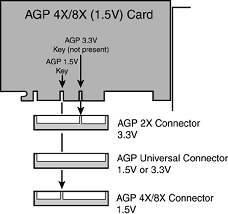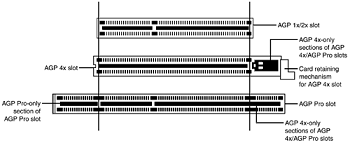Accelerated Graphics Port
Intel created AGP as a new bus specifically designed for high-performance graphics and video support. AGP is based on PCI, but it contains several additions and enhancements and is physically, electrically, and logically independent of PCI.
For example, the AGP connector is similar to PCI, although it has additional signals and is positioned differently in the system. Unlike PCI, which is a true bus with multiple connectors (slots), AGP is more of a point-to-point high-performance connection designed specifically for a video card in a system because only one AGP slot is allowed for a single video card.
Intel originally released the AGP specification 1.0 in July 1996 and defined a 66MHz clock rate with 1x or 2x signaling using 3.3V. AGP version 2.0 was released in May 1998 and added 4x signaling as well as a lower 1.5V operating capability.
Most newer AGP video cards are designed to conform to the AGP 4X or AGP 8X specification, each of which runs on only 1.5 volts. Most older motherboards with AGP 2X slots are designed to accept only 3.3V cards. If you plug a 1.5V card into a 3.3V slot, both the card and motherboard could be damaged, so special keys have been incorporated into the AGP specification to prevent such disasters.
Normally, the slots and cards are keyed such that 1.5V cards fit only in 1.5V sockets and 3.3V cards fit only in 3.3V sockets. However, universal sockets do exist that accept either 1.5V or 3.3V cards. The keying for the AGP cards and connectors is dictated by the AGP standard, as shown in Figure 1.

As you can see from Figure 1, AGP 4X or 8X (1.5V) cards fit only in 1.5V or universal (3.3V or 1.5V) slots. Due to the design of the connector and card keys, a 1.5V card cannot be inserted into a 3.3V slot.
So, if your new AGP card won't fit in the AGP slot in your existing motherboard, consider that a good thing because if you were able to plug it in, you would fry both the card and possibly the board as well! In that case, you'd either have to return the 4X/8X card or get a new motherboard that supports the 4X/8X (1.5V) cards.
Additionally, a newer specification was introduced as AGP Pro 1.0 in August 1998 and was revised in April 1999 as AGP Pro 1.1a. It defines a slightly longer slot with additional power pins at each end to drive bigger and faster AGP cards that consume more than 25 watts of power, up to a maximum of 110 watts.
AGP Pro cards are likely to be used for high-end graphics workstations and are not likely to be found in any normal PCs. However, AGP Pro slots are backward-compatible, meaning a standard AGP card will plug in, and a number of motherboard vendors are using AGP Pro slots rather than AGP 4x slots in their latest products.
Because AGP Pro slots are longer, an AGP 1x/2x card can be incorrectly inserted into the slot, which could damage it, so some vendors supply a cover for the AGP Pro extension at the rear of the slot. This cover should be removed only if you want to install an AGP Pro card.
The standard AGP 1x/2x, AGP 4x, and AGP Pro slots are compared to each other in Figure 2.

The latest revision for the AGP specification for PCs is AGP 8x, otherwise called AGP 3.0. AGP 8x defines a transfer speed of 2,133MBps, which is twice that of AGP 4x. The AGP 8x specification was first publicly pre-announced in November 2000.
AGP 8x support is now widely available in the latest motherboard chipsets and graphics chipsets from major vendors. Although AGP 8x has a maximum speed twice that of AGP 4x, the real-world differences between AGP 4x- and 8x-compatible devices with otherwise identical specifications are minimal.
However, many 3D chipsets that support AGP 8x are also upgrading memory and 3D graphics core speeds and designs to better support the faster interface. AGP is a high-speed connection and runs at a base frequency of 66MHz (actually 66.66MHz), which is double that of standard PCI.
In the basic AGP mode, called 1x, a single transfer is done every cycle. Because the AGP bus is 32 bits (4 bytes) wide, at 66 million times per second it would be capable of transferring data at a rate of about 266MBps! The original AGP specification also defines a 2x mode, in which two transfers are performed every cycle, resulting in 533MBps.
Using an analogy in which every cycle is equivalent to the back-and-forth swing of a pendulum, the 1x mode is thought of as transferring information at the start of each swing.
In 2x mode, an additional transfer would occur every time the pendulum completed half a swing, thereby doubling performance while technically maintaining the same clock rate, or in this case, the same number of swings per second. Although the earliest AGP cards supported only the AGP 1x mode, most vendors quickly shifted to the AGP 2x mode.
The newer AGP 2.0 specification adds the capability for 4x transfers, in which data is transferred four times per cycle and equals a data transfer rate of 1,066MBps. Most newer AGP cards now have support for the 4x standard as a minimum, and the latest graphics chipsets from NVIDIA and ATI support AGP 8x.
Because AGP is independent of PCI, using an AGP video card frees up the PCI bus for more traditional input and output, such as for IDE/ATA or SCSI controllers, USB controllers, sound cards, and so on.
Besides faster video performance, one of the main reasons Intel designed AGP was to allow the video card to have a high-speed connection directly to the system RAM, which would enable a reasonably fast and powerful video solution to be integrated at a lower cost.
AGP allows a video card to have direct access to the system RAM, either enabling lower-cost video solutions to be directly built in to a motherboard without having to include additional video RAM or enabling an AGP card to share the main system memory.
High-performance cards will likely continue the trend of having more and more memory directly on the video card, which is especially important when running high-performance 3D video applications. AGP allows the speed of the video card to pace the requirements for high-speed 3D graphics rendering as well as full motion video on the PC.